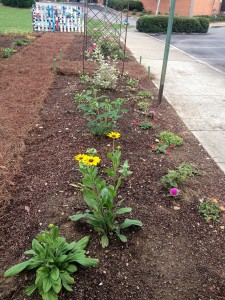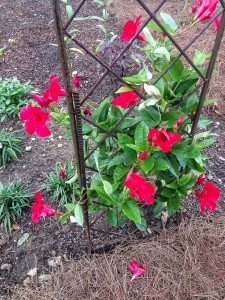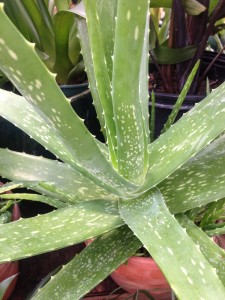
You’re undoubtedly familiar with this Aloe vera…
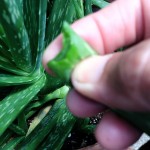
A basic aloe plant – and it’s soothing gel…
The succulent world is full of an amazing and beautiful variety of plants with mysterious names like Echevaria, Hechtia, Aeonium, Senecio, Crassula, Haworthia, and Graptoveria, just to name a few! Even the basic Aloe vera plant has been hybridized. It’s definitely no longer the aloe your mom had on the windowsill in the kitchen, there at the ready to soothe burns from the stove or the sun.
One of the preeminent hybridizers of aloes is a gentleman by the name of Kelly Griffin, formerly of Rancho Soledad Nursery. As is so often the case in horticulture, folks like him become interested in a particular group of plants, become educated in them, and have the great fortune to be able to pursue their interest, traveling the world and crossing plants to create beautiful hybrids.
The link HERE gives you a great picture of the man and his passion for aloes, agaves, and other succulents. The hybrids Mr. Griffin has produced really are very special, and many are a cross between Gasterias and Aloe to create the hybrid Gasteraloe. Pretty nifty, right? They are also commonly called “Table-Top” Aloes. Gasterias have been in cultivation for hundreds of years and can easily be crossed with Aloes, so there are many of these hybrids available.
With the interest in all things succulent lately, it’s only natural that these aloes would cross our path, and we’ve added them to the greenhouse collection of succulents as they become available from our suppliers.
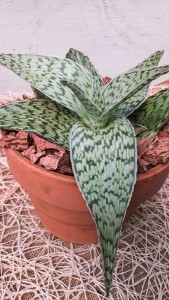
Aloe ‘Delta Lights’
One of the most beautifully patterned is the Aloe ‘Delta Lights‘, released in 2011. The parent plant, Aloe deltoideodonta, comes from southern central Madagascar, an island in the western Indian Ocean. Here in Birmingham, this, and the others mentioned here, will be a houseplant or one that can be summered outside in a container. Morning sun and occasional watering are perfect for this tough plant. Ultimately this beautifully patterned aloe can reach 18 inches tall by about 2 feet wide, with leaves on a healthy plant 3 inches wide at the base and tapering gently at the tips.

Aloe ‘Green Sand’
If you like ‘Delta Lights‘, the next one, ‘Green Sand‘, is even more colorful and unique and considered one of Griffin’s best. More compact, it boasts reddish to maroon tones that become a very deep, rich red the more sun it is provided. The serrated, bumpy leaves add even more interest to this pretty aloe.
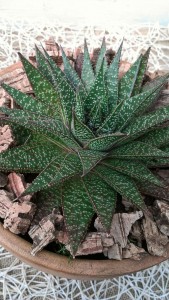
Gasteraloe ‘Flow’
The final Gasteraloe is one called ‘Flow‘. It has thick, oblong leaves with white, bumpy protrusions that give it quite a wonderful texture. This fascinating plant is yet another cross, this time using Gasteria verrucosa, a native of South Africa. If only world human populations could get along as well as these plants!
We will continue to carry these and other Table-Top aloes as they are available throughout the year. Any of them would make a wonderful gift for plant lovers in your life or an easy office or houseplant in plenty of bright light and minimal water.

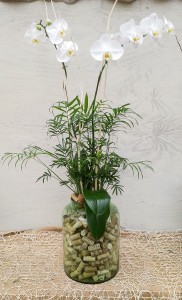
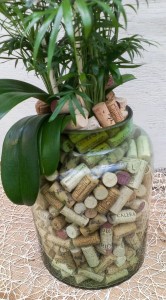
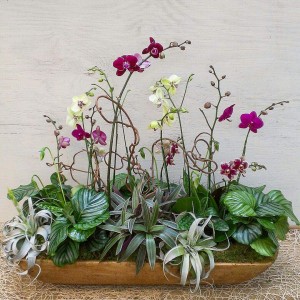
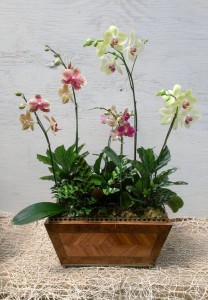

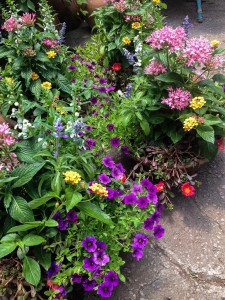
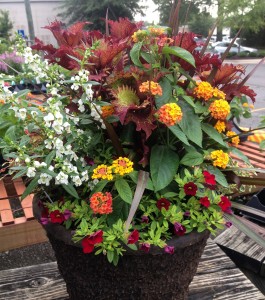 Many of the container plantings we do are in light, mâché pots that can either be used on their own or placed in another planter. Here’s one with a mix of sun coleus, a dracaena (Barely visible in this picture, it adds a spiky leaf.), lantana, red million bells to trail, and a white angelonia. This planting will get much larger and fuller as the heat of summer settles in, and daily watering will be necessary.
Many of the container plantings we do are in light, mâché pots that can either be used on their own or placed in another planter. Here’s one with a mix of sun coleus, a dracaena (Barely visible in this picture, it adds a spiky leaf.), lantana, red million bells to trail, and a white angelonia. This planting will get much larger and fuller as the heat of summer settles in, and daily watering will be necessary.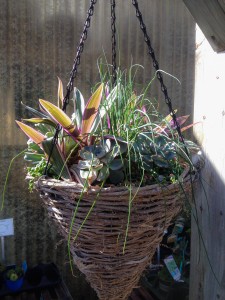 The white, cone-shaped hanging basket shown here is now home to a common houseplant, an herb, and some succulents. While it may seem an unusual combination, it’s working quite nicely and has a cool, summery look. The houseplant is a pink and green tradescantia (It’s also known as Rhoeo spathacea.), sometimes called Moses In The Cradle.
The white, cone-shaped hanging basket shown here is now home to a common houseplant, an herb, and some succulents. While it may seem an unusual combination, it’s working quite nicely and has a cool, summery look. The houseplant is a pink and green tradescantia (It’s also known as Rhoeo spathacea.), sometimes called Moses In The Cradle.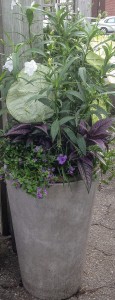 We have a few tall, lightweight planters still available, and this planting shows one of them off. A tall, white ruellia (They’re sometimes called perennial petunia.) is combined here with a caladium whose leaves will get very large. The name of this one is ‘Garden White’, and it’s impressive! The large leaves will contrast nicely with the smaller leaves of the ruellia. Another foliage contrast is provided by the silvery-purple leaves of a strobilanthes, sometimes called Persian Shield. A beautiful foliage plant, it benefits from a cutback every now and then if it gets to lanky in the planting. To trail there’s a blue fanflower, scaevola.
We have a few tall, lightweight planters still available, and this planting shows one of them off. A tall, white ruellia (They’re sometimes called perennial petunia.) is combined here with a caladium whose leaves will get very large. The name of this one is ‘Garden White’, and it’s impressive! The large leaves will contrast nicely with the smaller leaves of the ruellia. Another foliage contrast is provided by the silvery-purple leaves of a strobilanthes, sometimes called Persian Shield. A beautiful foliage plant, it benefits from a cutback every now and then if it gets to lanky in the planting. To trail there’s a blue fanflower, scaevola. Finally, since we had a few ‘Carolina Sapphire’ cypress left, they were candidates for a planting using smaller plants at the base to add fullness, color, and trail. These planters will be in the sun and can be changed out in the fall with the addition of pansies and other cold weather plants for the winter season.
Finally, since we had a few ‘Carolina Sapphire’ cypress left, they were candidates for a planting using smaller plants at the base to add fullness, color, and trail. These planters will be in the sun and can be changed out in the fall with the addition of pansies and other cold weather plants for the winter season.